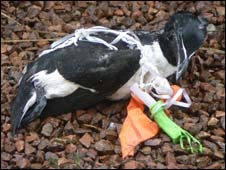Biodegradable Balloons: Better for the Environment?
Friday, October, 14th, 2011 Featured Litter News Recycled Products - Unusual
by Danielle Cotter
Since I was a little girl, I have been afraid of balloons for fear of accidentally letting one slip through my fingers and inadvertently causing the strangulation of an innocent dolphin or bird. Upon finding out about an impending balloon release on campus, I shuddered to think of all of the wildlife it might impact. Initially I was reassured that the balloons used would be biodegradable ones, but upon further research realized that all latex balloons are biodegradable, since they are comprised of a mix of organic compounds.
“Biodegradable” is one of those words used by companies to trick consumers into thinking that what they’re purchasing has a neutral, or even positive, effect on the environment. While looking at several sites clearly operated by balloon manufacturers, I repeatedly came across the same claim: “latex balloons biodegrade at the same speed as an oak leaf.” There aren’t any oak trees in my backyard, but leaves seem to disintegrate pretty quickly, right? Wrong! Oak leaves take at least six to eight months to biodegrade, and latex balloons are no different. In fact, when in saltwater, latex balloons can take up to a year to completely degrade. In the meantime, these balloon fragments make their home in major waterways and pose a serious hazard to various types of wildlife that live there.
In the oceans, these floating fragments of balloons end up as “food” for birds and marine
animals. Because balloons are often brightly colored and drift along the surface, many marine animals, such as turtles, dolphins and whales, mistake them for jellyfish or squid. There are many reports of these animals dying after ingesting fragments of the balloon; the balloons get lodged in their stomachs and block the normal passage of food, so the animals die of starvation. Birds and marine animals are also often strangled by the tails of balloons, which do not decompose.

